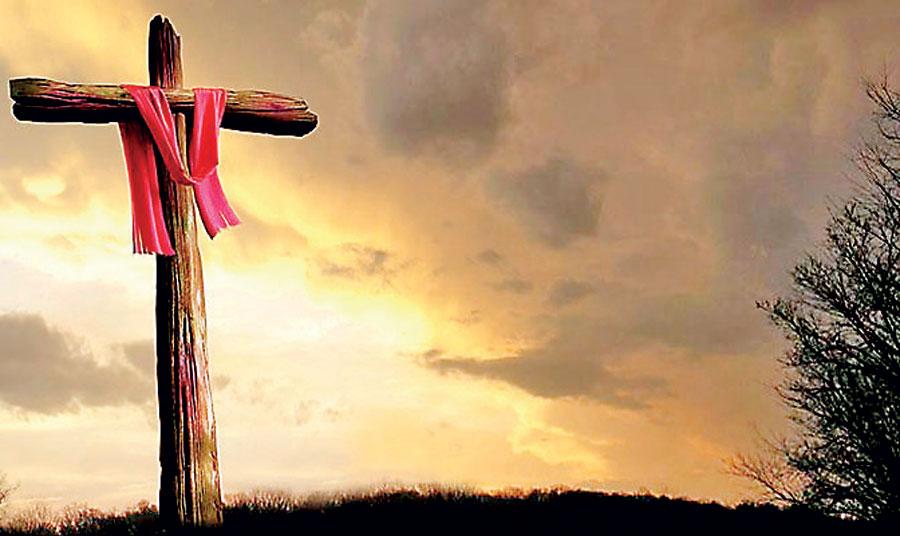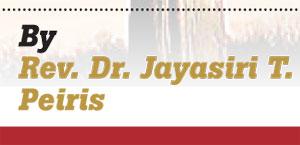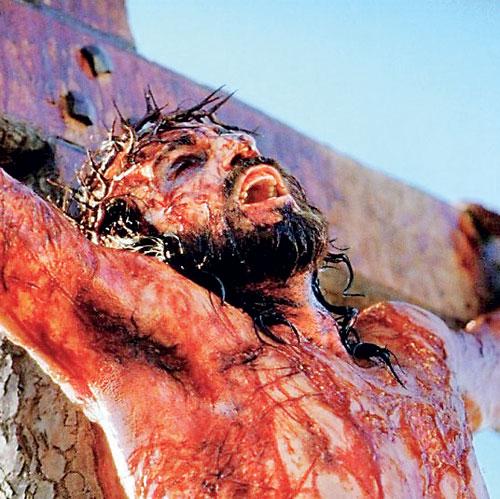Reply To:
Name - Reply Comment

Jesus is given various names/ titles in scripture. This reflection is on two names or titles; the first is the Prince of Peace, a title given to him, as recorded in Isaiah 9. The second is the Son of Man, which Jesus used to refer to himself. We cannot separate Good Friday from Christmas.
Christmas is the story of incarnation -- God coming into this world as a human being where various conflicts, false religion and political maneuvering existed. There was no palace, not  even a proper shelter for Jesus’ mother to give birth to her baby who was called Jesus later. Jesus, the Prince of Peace was born a victim. The Prince of Peace had no palace, he was born among animals. Soon after His birth He was displaced as the mighty powers of his time tried to kill him. He grew up in a foreign land as a refugee. When the time came for him to choose his vocation, instead of seeking positions, power and recognition both political and religious, he made a conscious decision to serve the people. That was to make this a better world where all types of corruption, manipulation and sin in various forms would be done away with and world with freedom, justice, peace and truth would prevail. He taught the people to depend on God and live on the values of the Reign of God as he himself did. When he came across vulnerable individuals and groups in society he associated with them and took remedial steps to raise their standards. To bring them back to society as equals and persons with dignity. The religious hierarchy detested such. They labelled him as a law-breaker, trouble-maker, a friend of the sinners and demon- possessed. Even in the midst of such criticism, he continued his work to create better situations and fulfil the vocation he chose.
even a proper shelter for Jesus’ mother to give birth to her baby who was called Jesus later. Jesus, the Prince of Peace was born a victim. The Prince of Peace had no palace, he was born among animals. Soon after His birth He was displaced as the mighty powers of his time tried to kill him. He grew up in a foreign land as a refugee. When the time came for him to choose his vocation, instead of seeking positions, power and recognition both political and religious, he made a conscious decision to serve the people. That was to make this a better world where all types of corruption, manipulation and sin in various forms would be done away with and world with freedom, justice, peace and truth would prevail. He taught the people to depend on God and live on the values of the Reign of God as he himself did. When he came across vulnerable individuals and groups in society he associated with them and took remedial steps to raise their standards. To bring them back to society as equals and persons with dignity. The religious hierarchy detested such. They labelled him as a law-breaker, trouble-maker, a friend of the sinners and demon- possessed. Even in the midst of such criticism, he continued his work to create better situations and fulfil the vocation he chose.
Many in the world consider peace as the absence of war. On the contrary peace is well-being where acceptance, dignity, equality, health, justice, peace, truth and other core values in society exist.
St. John 8: 1- 11 is a beautiful story where Jesus challenged the religious law and took courageous steps to protect the life of a victim; a woman caught in the act of adultery. People brought before Jesus a woman caught in adultery. They inquired what Jesus has to say about fulfilling the Mosaic law, which approves the taking away the life of that person! It was an interesting and a difficult question. ‘What do you say?’ is what the people asked Jesus. The law says to stone, but what do you say? Jesus had to decide whether to uphold the bias law and justify the killing of the woman one side or show the shortcomings in the law, human sinfulness on the other hand. Further should he allow such sinful acts to continue in society and what would be society if that happens or should he take steps to protect her. What about the situation if she continues to sin again and again. Jesus had to decide quickly with these various options. Should he say yes to killing, which is against the Ten Commandments, which says, ‘You shall not kill’ (Exodus 20: 13). In this narrative, there is no mention of the man/ men caught in the act. The people who brought the woman before Jesus have already allowed the man/ men to go squat free. Men have escaped the punishment. If Jesus says no he will be called a trouble-maker and a friend of the sinners. What would happen if he protects her? Would it lead to giving a green light or permit the woman to continue in sin? Wouldn’t that lead to a lawless society? Jesus gave an interesting answer, ‘whoever has no sin, let that person throw the first stone at her’. With this response Jesus exposed the hypocrisy of the people who were trying to stone the woman. See what they have done with the man or men who were involved in the same act! They have allowed the man to go squat free. Jesus identified the shortcomings in the law and how partial it was. It was against women. With that response whoever has no sin, let him throw the first stone all the people dropped the stones and left the place. Again Jesus had to decide and said to the woman, ‘I do not condemn you. Do not sin again’. Jesus took steps to protect her as well as rehabilitate her. Jesus, the Prince of peace  not only saved the life of this woman, but also was able to speak to the conscience of those who were to get rid of her, and also rehabilitate the woman. It is quite possible that many at that time would have labelled Jesus, but Jesus didn’t bother about such criticisms. Jesus knew what it means to be a victim due to unjust structures. So he could easily identify with other victims. Jesus, the friend of the victims had no place to lay his head. In today’s terms he was landless and penniless. Because of that poverty he was able to stand against all types of corruption and empty religiosity that had no spirituality.
not only saved the life of this woman, but also was able to speak to the conscience of those who were to get rid of her, and also rehabilitate the woman. It is quite possible that many at that time would have labelled Jesus, but Jesus didn’t bother about such criticisms. Jesus knew what it means to be a victim due to unjust structures. So he could easily identify with other victims. Jesus, the friend of the victims had no place to lay his head. In today’s terms he was landless and penniless. Because of that poverty he was able to stand against all types of corruption and empty religiosity that had no spirituality.
- "Christmas is the story of incarnation God coming into this world as a human being where various conflicts, false religion and political maneuvering existed"
- "He taught the people to depend on God and live on the values of the Reign of God as he himself did"
- "With this response Jesus exposed the hypocrisy of the people who were trying to stone the woman"
Jesus, the Son of man identified the religious and political leadership as working against people and God. They were agents of the empire who promoted the empire of their day. Jesus was very harsh on both the religious and political leadership. Many ‘holy’ people of his day who performed many religious acts worshipped the empire instead the true God who is the God of communities and the God of the victims. Jesus referred to the religious leaders of his day as hypocrites and whitewashed tombs and called the political leadership ‘fox’. When Jesus challenged both these they didn’t like it.
The political and religious leadership of his time were very annoyed that they collaborated with one another and put Jesus to death as a criminal. That took place outside the city. He was buried in someone else’s tomb. Jesus was born a victim, lived the life of a victim and put to death as a victim. During his time on this earth he asked those who wanted to be his disciples to deny self, take up the cross and follow him. That call was to become people who turn the world upside down; to establish peace on earth. ‘Your Kingdom come, your will be done on earth as it is in heaven’.
Every Good Friday reminds us to follow the victim Jesus. What matters today and always is to make a conscious decision and follow the victim Jesus who came to this world to make a difference. For that it is of vital importance to identify the empire operating in our society and resist that. Empire tells all the time to do what they ask. Empire all ways expands territory and colonize the minds of the people. Jesus never expanded territory. Jesus’ path was service and not being served. If we fail to do that, we are not worthy to be called disciples of Jesus who was crucified on a day like this. If not what would happen is that we would worship idols, not the crucified Jesus.
In the recent past, there is much talk on the media about the reintroduction of the death penalty to those who continue to operate the drugs mafia while serving a prison sentence. We need to look at the death penalty in our country today in the light of the life and work of Jesus the victim who was referred to as the Prince of Peace. Most probably, Jesus would look at things differently as he is the Son of Man who was called the Prince of Peace. He would advocate the following:
i) Take necessary steps to address the issues of consumption
ii) Take necessary action to stop the production of drugs
iii) Take steps to stop their movement and transport
iv) Take steps at least to minimize if not eradicate corruption at various levels
v) Rehabilitation of those involved in the drugs business and use
How do we look at the death penalty and related issues? I presume this is a modern day issue.